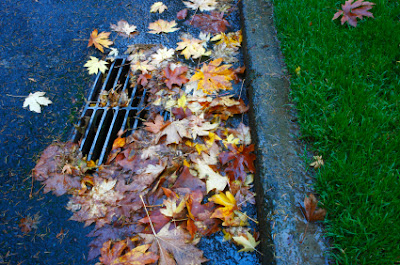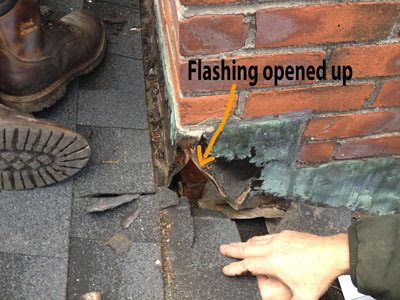Rain, rain go away!
Rain is coming and a lot of it, St. Louis... tis the season of the WET BASEMENT, friends!As far as area properties go, our current local forecast has the ability to turn even the most dry basement into a wet one as there is nowhere for all of this water to go?! Trickles, drips, streams, and in the worst scenario INCHES= extreme stress and costly repair for Homeowners.

Over 18+ years of building inspections as a St. Louis Realtor, one thing I know to be true: a large percentage of water damage is preventable. Deferred maintenance, red flags ignored, defects like cracks in the foundation brushed off, or water allowed to pool at a foundation or penetrate, one way or another, will eventually cause water damage.
I can assure you from personal experience that water is a property's worst enemy. In a very short period of time, water can cause massive and permanent structural damage in the form of mold/ rot/ foundation cracks, not to mention unnecessary Homeowner stress and damage to personal property.
Do you fear water penetrating your house this week? Is that an issue that you tend to have? Don't just sit back and stress. Protect your investment! Pop on a raincoat and proactively make your way through this basic checklist to help troubleshoot and reduce the damage.
Do you fear water penetrating your house this week? Is that an issue that you tend to have? Don't just sit back and stress. Protect your investment! Pop on a raincoat and proactively make your way through this basic checklist to help troubleshoot and reduce the damage.
1) Clear Gutters of All Obstructions
Is water spilling over the edges of your gutter? Is water spraying with force at the gutter seams? Is water not coming out of the downspout? Are your gutters pulling away from the house due to weight? Is your siding or fascia peeling or showing wear up near the gutter? Most likely, you have a clog and need to clear it ASAP!
Plain and simple, if your gutters are not working correctly, your basement will likely LEAK. Clearing all Spring debris or squirrels nests allows water to flow freely, ensuring the excess water gets where it should be instead of sitting at your foundation where it can potentially pool below ground.
2) Place Splash Blocks Beneath The Downspouts
Splash blocks direct rain water away from the foundation of the home and prevent soil erosion, ensuring the critical soil at the base of your foundation remain compact and as dry as possible. At just $10-$15 a piece, splash blocks are one of the most cost effective and simple water solutions a Homeowner has access to. Make sure that you install it correctly, not backwards, or it will flow right back towards your foundation defeating the purpose. This is more common than you think!
3) Ensure Downspouts Direct Away From The Foundation.
Are your gutters clear and you have a splash block, yet water continues to pool near the foundation? Quick fix ...
... a $10 downspout extender from a hardware store. It slips right on the end of the gutter and will immediately give you enough length to get the water AWAY from the foundation. These inexpensive contraptions allow water to be dispersed far from your home foundation, so it will absorb into the top soil evenly.
Temporarily, place them per above... it will do the trick! They can also be buried for a more aesthetically pleasing solution. If you have this system in place and you are still getting water, you likely have a breach- major clog or a break in the pipe. Temporarily disconnect the gutter from the buried pipe and redirect the water until you have sunny skies to excavate and repair!
4) Clear All Exterior Drains
If I had a dollar for every clogged driveway drain that I have witnessed cause active garage flooding or basement stairwell drain covered in leaves allowing water to flow right into the basement... I would be one wealthy Realtor.
Common sense: drains are there for a reason! Get in the habit of keeping all exterior and landscape drains clear of debris. If you don't, you are compromising your structure by inviting water right in.
5) Ensure That Your Sump Pump Hasn't Failed.
A sump pump is typically installed in a property with a high ground water table to avoid likely water penetration. They are also commonplace in most Midwest new construction properties. When the water table rises, the system is activated and quickly pumps water away via a drain pump trench dug around the structure foundation. Unfortunately, sometimes they fail which can cause a flooding catastrophe!
Power failure is the most common culprit, as sump pumps are hardwired and run on electricity. In that case, a backup generator is a quick and easy purchase at a hardware store, easily justified by the threat of a severely flooded basement. If the electricity is on and you STILL have pump failure, this article will help you troubleshoot! If your basement takes on a lot of water and often, a sump pump is a worthwhile solution as long as you commit to regular maintenance and testing. However, installation of a sump system is futile unless done in conjunction with the other steps in this blog post. A pump can only do so much.
Personal opinion: Do not invest in a sump pump unless you are willing to invest in a backup generator, as well. It is necessary. In addition, I have learned over the years that sump pumps are typically an automatic exclusion on most insurance policies, and require additional policy to provide failure coverage. If you have a sump pump, inquire with your insurance agent about adding a sump pump policy ASAP. If you don't and your pump fails causing property damage... it will result in out-of-pocket expense.
6) Ensure Basement Window Wells Are Not Taking On Water
Basement window wells serve a purpose, but if taking on water... they are a red carpet welcome for water into the basement. The 1st five items on this checklist could EASILY be causing the problem so start there. If your basement window wells are clean and still leaking after checking 1-5, it likely comes down to 1 of 4 things:
A) You need to caulk and seal the windows.
B) You have a grading issue that needs addressing ASAP(see #10)
C) You need a well cover, ala THIS, to help redirect rainfall if the window isn't located safely under the protection of the eaves.
D) You have cracks in the foundation near the windows that need to be addressed by a professional foundation company.
7) Ensure the Service Pipes And Wires Leading Into the House Are Tight And Sealed.
Electric, cable, gas, telephone, and plumbing services are all fed to your property via service wires and pipes coming through the structure. Ensure the boxes and meters aren't loose. Ensure the openings are properly caulked and sealed around the service entry to ensure that water doesn't penetrate. The most common and SCARY one that I see at inspection regularly? Electric panels with interior rust, as water droplets directly enter the box via beading on the entry wire.
Water + electricity= disaster.
In general, caulk and weather stripping in a Homeowner's best friend in ANY area of their house where they feel draft or see light.
8) Ensure your Roof Shingles and Flashings Are Secure And In Good Condition
Simply, a well-maintained roof is a property's most important defense against water. Deferred maintenance is a huge no-no. A teeny leak can result in severe structural damage in the matter of minutes. Check your roof regularly. Upon the VERY first sign of water penetration, contact a professional ASAP.
DO NOT PUT THIS ONE OFF.
9) Check Your Chimney
To ensure that a chimney doesn't leak, it should be properly maintained. If it isn't properly maintained, it is the most common water entry point on the roof. If the cap is missing or damaged, replace/tighten it. If the crown is cracked, caulk it or have it replaced by a professional. If moisture is seeping in, the bricks may need tuck-pointing. Per flashing, see #8.
10) Ensure That The Soil Is Properly Graded AWAY From The Foundation.
Obviously, this is not something that can be address MID-STORM, but often times water issues in the Midwest come down to grading. If you have any low areas where water is able to pool at the foundation, you have trouble! Ideally, your yard grade should be sloped away from the house, as water flowing towards the home almost always causes issue.
I discuss grading with my clients regularly, pertaining to water drainage issues. Sloping the soil away from the foundation will remedy a wet basement most of the time. The Family Handyman recommends firmly packing clay soil around the foundation, with at least a 4-in. slope over the first 4 ft. Place 6-mil black plastic over the soil and cover it with landscape rock...
Whatever method you choose to regrade your foundation beds, should you see any pooling it isn't working and it is time for a redo!
The key to successful home maintenance is proactivity. Deferred maintenance always comes back to bite a Homeowner during wicked weather systems like this. Hopefully these tips will get you through this particular storm system. Once sunny skies return, however, proactively troubleshoot the areas that were compromised during the storm to prevent future water penetration.













